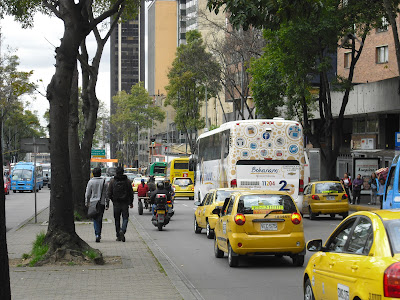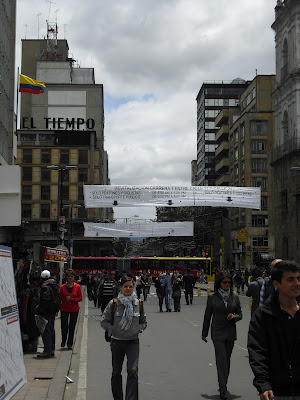Outside of its natural beauty, another thing that attracts many Westerners or those from the developed world (whatever that means) to Latin America is the difference of the place compared to home. The not-very-organised confusion if you will. It can be refreshingly chaotic, at least for a time.
In a more specific sense, we highlighted previously (see ‘Bogotá’s Transport Truths’) this kind of chaos in terms of transport here in Bogotá, our home, on and off, for the best part of a year.
 |
| Die-hards: Bogotá's old-school, diesel-guzzling buses. |
We mentioned then, that despite its many flaws, we preferred the colourful colectivo/buseta public transport system over the more modern Transmilenio (the city’s ‘far from efficient but getting there’ tram service on wheels).
This attraction, however, with the old-school buses, their colourful handcrafted route displays and devil-may-care way of operating may, sadly in some respects, be coming to an enforced end.
It’s all to do with the rolling-out of the city’s SITP or integrated public transport system.* In a bid to modernise the metropolis, the old way of doing things is being phased out.
It’s all to do with the rolling-out of the city’s SITP or integrated public transport system.* In a bid to modernise the metropolis, the old way of doing things is being phased out.
So, over the next few months and years residents of Bogotá must learn to catch a bus at an actual bus stop, which means the bus drivers will have to get out of the habit of aggressively braking to pick up passengers at random locations.
With the introduction of a cashless, card system the days of waving a 1,000 peso note at the driver – the accepted sign that you are only willing/able to pay two-thirds of the fare – will be numbered. If your card isn't charged with the sufficient amount, you won’t be able to board.
Well, that’s the theory anyway. No doubt a few crafty Bogotanos will find a way around this.
Besides, what about the steam of individuals boarding the current buses, without paying, selling things such as DVDs and pens to books and chocolate and everything else in between? Surely they're not just going to disappear.
The travel-card system will also mean that the bus drivers will only have to concentrate on actual driving.
 |
| Facing the axe: the ass-and-cart is fighting for its future. |
The admirable skills they have required of managing to, more or less, keep the bus on the road while dishing out the correct change to an endless string of passengers will become defunct. Getting around Bogotá will no doubt be a far duller experience for all these changes.
However, for those of you with a soft spot, like us, for the simple, more rustic way of doing things you’ll be glad to know that old habits and buses die hard around these parts.
However, for those of you with a soft spot, like us, for the simple, more rustic way of doing things you’ll be glad to know that old habits and buses die hard around these parts.
You just need to take a look north to the more ‘cosmopolitan’ Panama City to see how the old-school system refuses to go away despite the city’s rush towards ‘modernisation’. Although Panamanians have got used to using assigned bus stops.
Now, of course, there are obvious positives in this attempt to ‘clean up’ Bogotá’s transport system. A new, modern fleet of buses should mean that they are cleaner and more fuel efficient than most of the old-guard monsters currently on the prowl.
Now, of course, there are obvious positives in this attempt to ‘clean up’ Bogotá’s transport system. A new, modern fleet of buses should mean that they are cleaner and more fuel efficient than most of the old-guard monsters currently on the prowl.
In fairness, that’s not stating a lot considering the choking emissions from the archaic buses resemble those of a decent-sized factory. Anything that might do even the slightest bit to freshen up the city’s light, oxygen-deprived air has to be welcomed.
But while it might be one step forward for the seemingly progressive Mayor Gustavo Petro in the above regard on reducing carbon emissions from transport, it’s at least a sixth of a step back in another way: the banning of the ass-and-cart from the city’s thoroughfares in the coming months.
But while it might be one step forward for the seemingly progressive Mayor Gustavo Petro in the above regard on reducing carbon emissions from transport, it’s at least a sixth of a step back in another way: the banning of the ass-and-cart from the city’s thoroughfares in the coming months.
Come on, the emissions from the humble ass (that’s the animal we’re referring to here) are nothing compared to those gas-guzzling vehicles, the old or new ones.
 |
| The changing face of Carrera Septima. |
Perhaps, though, they’ll still be allowed to mosey on down Carrera Septima (Seventh Street), now that its partial pedestrianisation is up and running.
As one of Bogotá’s most iconic and important arteries, leading right into the main square, Plaza Bolívar, this move is welcome, despite the opposition by some local traders.
Indeed, in the long run, it’s these very same local traders who may benefit the most from taking the traffic off this street.
All these new developments are an attempt to bring Bogotá in line with the very best cities, not just in South America, but across the globe. And as the chief urban centre in a country that is changing – ever so slowly, but changing nonetheless – its negative, dangerous image to the outside world, all the above can be seen, in general, as positive.
All these new developments are an attempt to bring Bogotá in line with the very best cities, not just in South America, but across the globe. And as the chief urban centre in a country that is changing – ever so slowly, but changing nonetheless – its negative, dangerous image to the outside world, all the above can be seen, in general, as positive.
For those of you who fear the city and its inhabitants may lose a little bit of their uniqueness, there’s much more to this place and its people than how they commute.
However, on a broader scale, modernisation does not always mean ‘cleaner and greener’ — on the contrary, in some cases it can mean quite the opposite.
However, on a broader scale, modernisation does not always mean ‘cleaner and greener’ — on the contrary, in some cases it can mean quite the opposite.
So as many ‘developing countries’ try to play catch-up with the ‘developed’ ones, it’s worth bearing in mind the following stat we came across recently: If the world’s poorest four-fifths were to live like the richest one-fifth, at current consumption levels, we would need four planet earths to sustain us.
Some food for thought that.
_________________________
*SITP stands for Sistema Integrado de Transporte Público de Bogotá, or Bogotá's Integrated Public Transport System.
Some food for thought that.
_________________________
*SITP stands for Sistema Integrado de Transporte Público de Bogotá, or Bogotá's Integrated Public Transport System.
Good piece this! Very topical! I actually learned something :)
ReplyDeleteYou mean you don't usually learn something from my musings?!
ReplyDelete